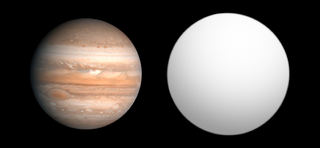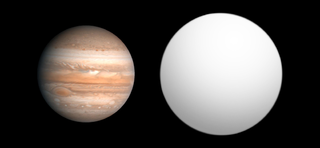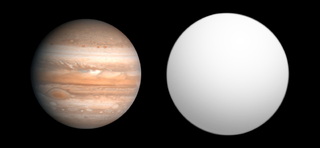
TrES-1b is an extrasolar planet approximately 523 light-years away in the constellation of Lyra. The planet's mass and radius indicate that it is a Jovian planet with a similar bulk composition to Jupiter. Unlike Jupiter, but similar to many other planets detected around other stars, TrES-1 is located very close to its star, and belongs to the class of planets known as hot Jupiters. The planet was discovered orbiting around GSC 02652-01324.

OGLE-TR-122 is a binary stellar system containing one of the smallest main-sequence stars whose radius has been measured. It was discovered when the Optical Gravitational Lensing Experiment (OGLE) survey observed the smaller star eclipsing the larger primary. The orbital period is approximately 7.3 days. The system's primary is thought to resemble the Sun.
OGLE-TR-111 is a yellow dwarf star approximately 5,000 light-years away in the constellation of Carina. Having an apparent magnitude of about 17, this distant and dim star has not yet been cataloged. Because its apparent brightness changes when one of its planets transits, the star has been given the variable star designation V759 Carinae.

OGLE-TR-10 is a distant, magnitude 16 star in the constellation of Sagittarius. It is located near the Galactic Center. This star is listed as an eclipsing type variable star with the eclipse due to the passage of the planet as noted in the discovery papers.
OGLE-TR-132 is a distant magnitude 15.72 star in the star fields of the constellation Carina. Because of its great distance, about 4,900 light-years, and location in the crowded field it was not notable in any way. Because its apparent brightness changes when one of its planets transits, the star has been given the variable star designation V742 Carinae. The spectral type of the star is type F. A yellow-white, very metal-rich dwarf star, it is slightly hotter and more luminous than the Sun.

OGLE-TR-10b is an extrasolar planet orbiting the star OGLE-TR-10.

The Optical Gravitational Lensing Experiment (OGLE) is a Polish astronomical project based at the University of Warsaw that runs a long-term variability sky survey (1992–present). The main goals are the detection and classification of variable stars, discovery of microlensing events, dwarf novae, and studies of the structure of the Galaxy and the Magellanic Clouds. Since the project began in 1992, it has discovered a multitude of extrasolar planets, together with the first planet discovered using the transit method (OGLE-TR-56b) and gravitational microlensing. The project has been led by professor Andrzej Udalski since its inception.
OGLE-TR-56 is a dim, distant, magnitude 17 Sun-like star located approximately 1,500 parsecs away in the constellation of Sagittarius. This star is listed as an eclipsing type variable star with the eclipse due to the passage of the planet as noted in the discovery papers.

OGLE-TR-56b is an extrasolar planet located approximately 1500 parsecs or 5000 light years away in the constellation of Sagittarius, orbiting the star OGLE-TR-56. This planet was the first known exoplanet to be discovered with the transit method. The object was discovered by the OGLE project, announced on July 5, 2002 and confirmed on January 4, 2003 by the Doppler technique. The period of this confirmed planet was the shortest until the confirmed discovery of WASP-12b on April 1, 2008. The short period and proximity of the OGLE-TR-56 b to its host mean it belongs to a class of objects known as hot Jupiters.
OGLE-2003-BLG-235L (MOA-2003-BLG-53L) is a star in the constellation of Sagittarius. The first gravitational microlensing event for which a planet orbiting the lens was detected around this star. The event occurred in during July 2003. Two groups observed and independently detected the event: the Optical Gravitational Lensing Experiment (OGLE) and the Microlensing Observations in Astrophysics (MOA), hence, the double designation. It is an orange dwarf star of spectral type K, which is accompanied by a giant planet.
OGLE-TR-113 is a dim, distant magnitude 16 binary star in the star fields of the constellation Carina. Because of its distance of about 1170 light years, and location in a crowded field it was not notable in any way. Its apparent brightness changes when one of its planets transits, so the star has been given the variable star designation V752 Carinae. Spectral type of the star is type K dwarf star, slightly cooler and less luminous than the Sun.
OGLE-2005-BLG-071L is a distant, magnitude 19.5 galactic bulge star located in the constellation Scorpius, approximately 11,000 light years away from the Solar System. The star is probably a red dwarf with a mass 43% of that of the Sun.
OGLE-TR-182 is a dim magnitude 17 star far off in the constellation Carina at a distance of approximately 12,700 light years.

WASP-11b/HAT-P-10b or WASP-11Ab/HAT-P-10Ab is an extrasolar planet discovered in 2008. The discovery was announced by press release by the SuperWASP project in April 2008 along with planets WASP-6b through to WASP-15b, however at this stage more data was needed to confirm the parameters of the planets and the coordinates were not given. On 26 September 2008, the HATNet Project's paper describing the planet which they designated HAT-P-10b appeared on the arXiv preprint server. The SuperWASP team's paper appeared as a preprint on the Extrasolar Planets Encyclopaedia on the same day, confirming that the two objects were in fact the same, and the teams agreed to use the combined designation.

OGLE-TR-211b is a transiting planet in Carina constellation. Its radius is about 36% more than Jupiter and has mass 3% more than Jupiter, which is considered an “inflated Hot Jupiter”. The planet takes 3.7 days at about the same distance as 51 Pegasi b orbits around 51 Pegasi.

OGLE-TR-113b is an extrasolar planet orbiting the star OGLE-TR-113.

OGLE2-TR-L9b is an extrasolar planet discovered by three undergraduate students from Leiden University, Netherlands. The planet is about 4.5 times as massive as Jupiter and is the first discovered planet orbiting a fast-rotating hot star.

OGLE2-TR-L9 is a magnitude 15 star in the constellation Carina at a distance of approximately 5,142 light years.

OGLE-TR-132b is an extrasolar planet orbiting the star OGLE-TR-132.

An exoplanet is a planet located outside the Solar System. The first evidence of an exoplanet was noted as early as 1917, but was not recognized as such until 2016; no planet discovery has yet come from that evidence. What turned out to be the first detection of an exoplanet was published among a list of possible candidates in 1988, though not confirmed until 2003. The first confirmed detection came in 1992, with the discovery of terrestrial-mass planets orbiting the pulsar PSR B1257+12. The first confirmation of an exoplanet orbiting a main-sequence star was made in 1995, when a giant planet was found in a four-day orbit around the nearby star 51 Pegasi. Some exoplanets have been imaged directly by telescopes, but the vast majority have been detected through indirect methods, such as the transit method and the radial-velocity method. As of 24 July 2024, there are 7,026 confirmed exoplanets in 4,949 planetary systems, with 1007 systems having more than one planet. This is a list of the most notable discoveries.












